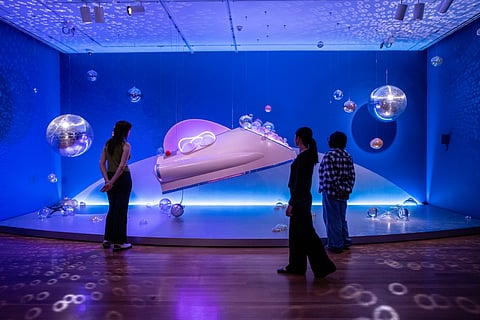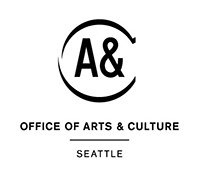Tariqa Waters' 'Venus is Missing' at the Seattle Art Museum Tasks Visitors With a Galactic Mission
The Seattle Art Museum's latest show might be the first one visitors have to "beam" into.
Seattle artist Tariqa Waters' "Venus is Missing" (up now through Jan. 5, 2026) invites viewers to immerse themselves in her cosmic vision of the future. The exhibition comes after Waters snagged the museum's coveted Betty Bowen Award in 2023, a biannual award recognizing a Northwest artist with $15,000 in unrestricted funds and a show at the museum. Replete with a Jetsons-like spaceship, a wall portal, and lots of ball-barrettes, "Venus is Missing" pulls from science fiction, music, and other cultural touchstones of Waters' childhood to create an immersive installation about what's next for humanity with her signature humor and pop art sensibility.
To get to Waters' side of the universe, one must stand literally in a beam of bright light at the front of the show (the "transporter" as it's called) and imagine all of their atoms broken apart, flying through space, and put back together on an alien planet. Just like in the old science fiction TV shows and films from the '70s and '80s. Once through this portal, a museum document tasks visitors with a mission brief in "exploring the uncharted territories of vulnerability" with "Agent Waters." Easy enough!
Drenched in a bright royal blue and studded with disco balls, the gallery space is arranged around two giant set pieces. On one side is a pink retro-futuristic spaceship, "Future to the Back," inspired by a toy Waters found from the '60s and powered by a single set of ball-barrettes — a type of hair accessory ubiquitous in the late 20th century, especially in Black households. The ship is surrounded by hand-blown glass bubbles and barrettes Waters created during her residency at the Museum of Glass, adding a bubbly lightness to the scene.
Just opposite the ship is an 8-foot-tall, dusty-pink ball-barrette, "Hold Tight," seemingly captured in a moment just before it hits the floor. The hair accessory is a common presence throughout Waters' work, inspired by the time spent doing her hair with her mother and sister growing up. Despite the barrette's purpose of adornment, she remembers stepping on them and struggling to wrap them around her braids.
"This ball-barrette was the bane of my existence when I was a little girl. I could not stand it," Waters said, motioning to the sculpture. "I mean, they were very practical, but they had nothing to do with beauty." And so what was once a tiny nuisance, Waters flips on its head and irreverently memorializes in a larger-than-life-sized sculpture.
On the far wall is "A.O.A.E.," a vinyl image of a young woman, Waters' daughter, in futuristic attire beaming into a 1985 photograph of Waters' childhood home's front porch, connecting the artist's past kid self with her future child as if the two have always coincided with one another. Staticky music is piped throughout the gallery space, a mix of artists Waters' grandma used to listen to, like Herbie Hancock and Luther Vandross, obscured by what sounds like a bad radio signal.
"We're playing with the radio frequencies with that spaceship traveling through time, trying to make those connections back to time," said Waters. "Maybe it's Earth, maybe it's something it's picking up in space that sounds a little different."
Born in Richmond, Virginia, and a Seattle resident for the past nearly 15 years, Waters blasted onto the scene in 2012 with her gallery/beauty supply Martyr Sauce in Pioneer Square, racking up accolades, like the 2020 Neddy Award, and opening another gallery, Martyr Sauce Pop Art Museum (MS PAM) along the way. Her work has also appeared in places like the Bellevue Arts Museum, the Northwest African American Museum, and the Brooklyn Museum.
Waters has always been interested in larger-than-life pop cultural artifacts and situating her life in relation to them. From her huge Quilted Northern toilet paper sculpture to a giant, swiveling Julia-themed lunchbox, Waters often inserts her visage onto these everyday products as a way of cheekily commenting on representation and visibility. There's a humorous, imaginative quality to Waters' work that invites the viewer to do the same and picture themselves on a quotidian item or object that otherwise melts into the background of our everyday existence.
And in "Venus is Missing," Waters invites the audience to do the same imaginative work of envisioning themselves in a pink spaceship or diving into a portal or struggling with a monster-sized ball-barrette as a way to think about their own universe, their own future. You can go and check it out for yourself anytime from now through next January.
The Emerald's arts coverage is supported in part with funding from 4 Culture and the City of Seattle's Office of Arts & Culture. The Emerald maintains editorial control over its coverage.
Help keep BIPOC-led, community-powered journalism free — become a Rainmaker today.




